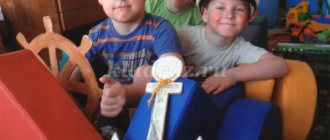The purpose of the didactic game “Who needs what”
The goal is to become familiar with professions and their associated attributes.
Tasks:
- consolidation of names and ideas about professions;
- familiarization with objects and tools used by specific specialists;
- developing the skill of relating work wardrobe to professions;
- fostering a respectful attitude towards work;
- strengthening cognitive interest;
- development of memory, speech skills, concentration, ability to think logically.
Role-playing game "Hospital"
"Hospital"
(role-playing game)
Educator: Abilova A.B.
Carried out: March 20, 2016
Target
: Work on developing skills in gaming activities, while reflecting the work of adults.
Tasks :
- Give basic knowledge about the work of a doctor, honey. employee, about the culture of behavior of those “being treated” in the hospital"
- Teach children to invent and depict various actions in a game situation.
- Develop a sense of community and interest while playing.
- Expand children's knowledge.
- Cultivate friendly relations and respect for the work of adults.
Preliminary work:
Excursion to the medical center office at the building
Conversations about the profession of a doctor, honey. sisters.
Reading poetry by K.Ya. Chuikovsky “Aibolit”, examination of illustrations.
Making attributes in the game with the hands of children, involving them in equipping the developmental environment.
Watching
DVDs .
Progress of the game.
Surprise moment:
Guys, the postman brought us a parcel today. Let's see what he brought? (white suitcase with a red cross)
- Guys, do you know what kind of suitcase it is?
- That's right, this is a medical suitcase!
-How did you know?
-What is it for?
-Let's see what's in the suitcase. What medical instruments do you recognize? (syringes, cotton wool, medicines, outpatient records, clothes for doctors, etc.)
- Guys, what are medical instruments and medicines for? (treat the sick)
—Let's play the game "Children's Hospital".
-Who do we need for this? (distribution of roles). Doctor, med. sister, patient, etc.
Play area: “Home”, “hospital”, “ambulance” (children wear badges with the name of the role)
-And I will be the head of the clinic, observing the work of the doctors and how the patients are treated.
Game plot:
They bring a mother and daughter from home by ambulance and want to put her in the hospital.
Doctor:
listens, looks at the throat, touches the stomach, asks what hurts, makes a diagnosis, prescribes medicine, gives injections.
Honey. sister:
lays out the medicine, brings and distributes it to the sick, sets up thermometers, IVs, brings lunches to the ward.
Ambulance driver:
accepts applications, brings patients to the hospital, repairs cars.
Patients being treated, 2 people each (mother + daughter, mother + son, mother + daughter, 3 wards), live in 3 houses, come to the hospital by ambulance, lie in a ward of 2 people, are treated, mothers take care of children, put them to bed , fed, clothed.
Game result:
- Guys, what game did we play?
-What medical instruments do you know?
-Who were you today?
-You now know that the work of doctors is very important and necessary for people.
-Did you enjoy playing?
Let's switch roles and play again.
Self-analysis of the role-playing game “Hospital”
In our mixed age group there are 9 pupils from 7 to 9 years old. The children's team is being formed at this stage.
I conducted a role-playing game “Hospital”. I chose this game because the main composition of my group is the primary class. The older student played the role of an experienced participant, since children of his age are characterized by a transition to role-playing actions and they adhere to their role throughout the entire game.
The following goals were set:
- Promote the transition from plot-based games to plot-role-playing games.
- To teach how to carry out game actions according to verbal instructions;
- To develop the consciousness of schoolchildren and to form a consciously correct attitude towards medical care. employee, hospital through the game.
To achieve the goal, the following tasks were performed:
To promote the development of cognitive interest in hospital life:
Memory training, attention, speech development of children; replenishment of vocabulary. During the game, methodological examples were used: conversation, demonstration, change of activities. I think that the task is completed, the goal is achieved.
Didactic game “Who needs what for work”
The game introduces preschoolers to specialists in various professions: policeman, builder, fireman, doctor, school teacher, salesman, cook, kindergarten teacher, artist, traffic controller.
For the lesson, you need to prepare large A5 size cards depicting representatives of the above professions. You also need to make smaller pictures, approximately 10x10 cm, depicting the objects and tools used by the represented specialists. The number of pictures is arbitrary.
You can play in several ways:
- Game for one player or a subgroup of 1-3 people. The presenter shows a card with a picture of the employee. Players select pictures with the tools that this specialist uses and give reasons for each of their choices. In a subgroup lesson, the player who makes the fewest mistakes wins.
- Game for a group. The presenter distributes cards with representatives of professions to the players. Then he shows pictures of objects one by one. The child, having guessed that this instrument is suitable for his specialist, picks up his card and explains the choice in detail.
- Individual game. The player takes any card he likes depicting an employee and talks in detail about the profession. Next, he selects pictures of the tools that the described specialist uses.
Play doctor
Nothing human is alien to medical workers, including the passion for computer games. 80% of American medical school students even believe that games “about doctors” have educational value. They are echoed by Russian specialists - last year they borrowed the SCA Life simulation program from their European colleagues, which helps to practice first aid skills for cardiac diseases.
Of course, people who, for one reason or another, did not go to study to become doctors, do not need specialized training programs. But the romance of white coats and selfless struggle for the life of a patient is so popular among ordinary people that serious corporations specializing in virtual entertainment for adults are developing computer games that are in one way or another related to medicine.
Didactic game “What a firefighter needs”
The game, intended for middle school preschoolers, expands their understanding of the work of a firefighter. The lesson requires an image of a firefighter, as well as pictures depicting the attributes and tools that this worker cannot do without: a helmet, a fire truck, a fire extinguisher, a box of sand, etc. You also need to make several pictures with objects not related to firefighting.
The player looks at pictures of objects and selects those that the fireman uses. He must explain in detail the purpose of each tool.
Work clothes
For this lesson you will need paper cut-out images of a boy and a girl, different types of work wardrobe, as well as corresponding professional tools.
The presenter explains that the paper dolls are going to work, and you need to help them choose a suitable wardrobe. Then he places a picture of a tool next to each doll, from which the players must guess what item of clothing is needed. Children dress dolls and name their profession. And so for every work clothing.





